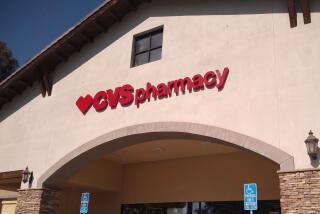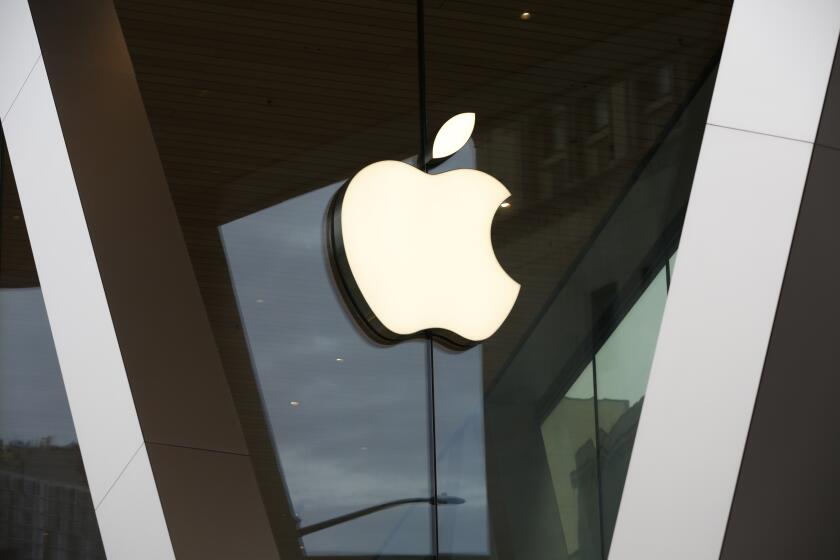This Year’s Magic Pill : Positive News for Big Drug Companies Has Their Shares Trading at Robust Multiples, but There May Be Good Value in Some Lower-Profile Firms
- Share via
If you’re an investor, drug stocks this year could have fixed whatever ails ya.
Shares of pharmaceutical companies have been on a tear in 1996, propelled by a growing economy, firming retail prices and changing managed-health-care trends, along with a flurry of new products, low debt levels, ongoing belt tightening and swelling profits.
Election day gave them yet another boost. With the Republicans keeping control of Congress, Wall Street calculated that President Clinton won’t be able to tinker much with the health-care industry and therefore jeopardize the drug makers’ growth.
As a result, the Standard & Poor’s index of major drug stocks has soared 27% this year, well outpacing the 19% gain of the S&P; 500 composite index.
But therein lies a problem for those thinking of buying drug stocks today: The shares have gotten pricey.
The drug stocks, on average, are trading at nearly 20 times their expected 1997 profits, well ahead of the S&P; 500’s 1997 multiple of about 17, according to analyst Kent Blair of Donaldson, Lufkin & Jenrette Securities in New York.
That’s just the average. Such industry giants as Eli Lilly & Co., Warner-Lambert Co., Pfizer Inc. and Merck & Co. (one of the Dow Jones 30 industrials) are trading 22 to 26 times their projected profits for next year.
Given the stocks’ values, it appears Wall Street has already discounted much of the companies’ earnings growth for the next year or two, no matter how strong that growth might be. So investors now “would probably do well” to buy the shares “mainly on price pullbacks,” Value Line Investment Survey analyst George Rho advises in a new report.
David Lippman, drug analyst at Prudential Securities Inc., likewise has put only two of the 13 major pharmaceutical makers he follows on his “buy” list: Bristol-Myers Squibb Co. and Schering-Plough Corp.
Of course, concluding that a stock has climbed too far too fast--what Wall Street likes to call “a stock getting ahead of itself”--and ignoring it for simply that reason can be a big mistake.
The histories of such familiar names as Wal-Mart Stores Inc., Microsoft Corp. and General Electric Co. are filled with occasions when their stocks were thought to be way overpriced and the “easy money” had been made. That was many years, and many billions of dollars in increased market capitalization, ago.
Because analysts see most of the drug companies’ earnings continuing to rise sharply over the next 12 months, one way to pick a drug stock today might be to focus on those that haven’t rallied as strongly as the others.
*
Case in point: British company SmithKline Beecham, whose American depositary receipts trade on the New York Stock Exchange. Known to consumers for such over-the-counter medicines as Contac for colds and Tagamet HB for heartburn, SmithKline also makes a variety of prescription drugs. And several of its new products for the U.S. market are enjoying strong sales growth.
Among them are Hycamtin, for ovarian cancer, and Nicorette and Nicoderm, which aren’t new but are newly available over the counter for smokers trying to quit. Also, a new twice-daily dosage form for its Augmentin antibiotic are driving sales of that drug higher.
As a result, SmithKline’s ADRs have climbed to about $64 lately from $54 at the start of the year, a 19% advance--the same gain as the S&P; 500. But much of SmithKline’s advance has come only in the last four months, and it’s still lagging the industry’s hotshot stocks, so it remains “an attractive entry point for investors,” said analyst Steven Gerber of Oppenheimer & Co.
There’s one other reason why investors might not want to turn their backs to the drug stocks: The prospect of more mergers. When the Swiss pharmaceutical companies Ciba-Geigy and Sandoz announced their colossal $27-billion marriage in March, speculation rose that more firms would join forces in order to become more efficient and keep their costs down.
Why? Despite the industry’s bullish conditions today, few doubt that drug makers will continue to feel pressure to cut prices--pressure from governments, insurance companies, hospitals and the rest of the health-care industry.
Many managed-care firms, for instance, already insist that their patients be given cheaper generic prescription drugs instead of premium brands whenever possible.
Speaking of which, how are the generic-drug stocks doing? Not especially well. Much of the generic industry is suffering from bloated inventories and widespread price cutting, in good part because there haven’t been many branded drugs that lost their patent protection this year. Patent removal gives the generic makers new market opportunities.
Still, analysts see solid long-term growth for generic products. Indeed, drug wholesaler Bergen Brunswig Corp. agreed last week to buy generic-drug maker Ivax Corp. for $1.7 billion in stock, in good part to exploit Ivax’s market.
Some analysts also like Watson Pharmaceuticals Inc., a generic producer based in Corona, Calif., even though its stock has dropped 29% so far this year, to about $35 a share.
Watson’s profit is expanding nicely, the company is making acquisitions to diversify out of generics, and the stock is trading for a moderate 15 times its expected 1997 profit, analysts note.
(BEGIN TEXT OF INFOBOX / INFOGRAPHIC)
TOO MUCH MEDICINE?
A rally in drug stocks has outpaced that of the overall market this year, prompted by drug makers’ earnings growth and other solid fundamentals. But investors now must decide whether the shares are too rich in price.
*--*
Stock Symbol Recent price YTD % change 1997 P/E* Pfizer PFE $89.50 +42% 25.9 Eli Lilly LLY $75.50 +34% 24.4 Warner-Lambert WLA $70.50 +45% 22.7 Merck MRK $80.75 +23% 22.4 American Home Products AHP $62.50 +29% 18.0 Bristol-Myers Squibb BMY $110.00 +28% 17.5 Standard & Poor’s 500 734.25 +19% 17.2
*--*
*Price-to-earnings multiple based on estimated 1997 earnings per share
Source: Donaldson, Lufkin & Jenrette Securities
Sector Shuffle
A ranking of 12 key sectors representing the U.S. economy, based on the last five days of trading on major equity markets.
*--*
Sector 5-day %chg P/E Yield P/Book ROE Rev.Q/chg Technology 2.4 30.8 1.0 7.5 22.3 26.3 Capital goods 1.8 19.8 1.6 3.5 16.2 14.8 Basic materials 1.7 19.9 2.3 3.7 19.0 4.9 Consumer(non-cyc) 1.6 28.9 2.1 10.2 32.9 3.4 Energy 1.6 23.8 29 3.2 14.4 21.1 Conglomerates 1.5 22.6 1.8 4.8 21.0 8.0 Transportation 1.5 25.1 1.9 2.6 13.3 10.4 Financial 0.7 15.5 2.2 2.3 16.3 13.0 Consumer(cyc) 0.5 16.8 2.4 3.3 19.2 8.6 Services 0.2 25.5 2.6 4.0 15.4 19.7 Utilities 0.1 14.9 5.2 1.8 11.7 10.0 Health care -0.7 27.1 1.8 6.9 23.1 15.4
Sector EPS Q/chg Technology 22.6 Capital goods 17.7 Basic materials -0.8 Consumer(non-cyc) 7.6 Energy 25.2 Conglomerates 6.2 Transportation 14.4 Financial 8.3 Consumer(cyc) 37.8 Services 11.7 Utilities 5.3 Health care 18.7
*--*
Source: Market Guide; all data as of Friday
Note: Each sector includes several industry groups, which in turn are made up of individual stocks. You can examine the industry groups and individual stocks that make up each sector at https://www.marketguide.com/MGI/HOT/ on the World Wide Web.
Chart explanation: Sectors and sector data are weighted by market capitalization.
NM: Not meaningful. P/E: Friday price divided by most recent trailing one--year earnings. Yield: Annual return of dividend based on most recent stock price and recent dividend information. P/Book: Price to book; price divided by latest available quarterly book value per share. ROE: Return on equity, most recent available trailing 12-month period. Rev. and EPS: Revenue and earnings per share, percentage change in most recent quarter versus year-ago quarter.











